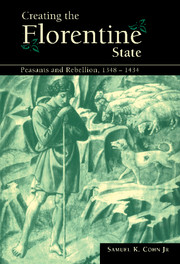Book contents
- Frontmatter
- Contents
- List of illustrations
- List of tables
- Acknowledgements
- Note on citations, dates, and measures
- Introduction
- PART I CULTURE, DEMOGRAPHY, AND FISCALITY
- PART II PEASANT PROTEST IN THE MOUNTAINS: THREE VIEWS
- PART III GOVERNMENTAL CLEMENCY AND THE HINTERLAND
- 7 Florentine peasant petitions: an institutional perspective
- 8 The reasons for assistance
- 9 What the peasants won
- Conclusion
- Appendix 1 Regression models: wealth, migration, and taxes
- Appendix 2 Tax coefficients, 1354–1423
- Bibliography
- Index
8 - The reasons for assistance
Published online by Cambridge University Press: 07 August 2009
- Frontmatter
- Contents
- List of illustrations
- List of tables
- Acknowledgements
- Note on citations, dates, and measures
- Introduction
- PART I CULTURE, DEMOGRAPHY, AND FISCALITY
- PART II PEASANT PROTEST IN THE MOUNTAINS: THREE VIEWS
- PART III GOVERNMENTAL CLEMENCY AND THE HINTERLAND
- 7 Florentine peasant petitions: an institutional perspective
- 8 The reasons for assistance
- 9 What the peasants won
- Conclusion
- Appendix 1 Regression models: wealth, migration, and taxes
- Appendix 2 Tax coefficients, 1354–1423
- Bibliography
- Index
Summary
To chart changes in public policy and in the mentality of the Florentine ruling elites, I have looked at what the oligarchy accepted as legitimate grounds for awarding governmental clemency to the hinterland and what these subjects actually won. This chapter will look at the reasons peasants and subject townsmen presented in their petitions in arguing for tax relief or, perhaps closer to the truth, what the ruling oligarchy saw, interpreted, and transcribed as these peasants' legitimate reasons. Before turning to these reasons, we will glance over the broad trends in peasant petitioning from the Black Death to the return of the Medici.
First, the numbers of approved petitions from the countryside show no correspondence between shifts of political regimes or changes in the Florentine constitution and swings in the number of successful petitions. For instance, the opening of the councils to greater proportions of minor guildsmen, 1378 to 1382, made no difference in the number of peasant petitions that passed through the councils: in the three years prior to the Ciompi revolt, the government approved twenty-three petitions from the hinterland; in the three years of Ciompi and minor guildsmen rule, it approved nineteen. Nor did the number change significantly with the restoration of the oligarchy in 1382 (see figure 8.1). Perhaps one might have expected the numbers to have risen to pay off contadini for their support in the suppression of the Ciompi, but instead they declined to sixteen, probably because of increased stability and reduced warfare.
- Type
- Chapter
- Information
- Creating the Florentine StatePeasants and Rebellion, 1348–1434, pp. 210 - 243Publisher: Cambridge University PressPrint publication year: 1999



